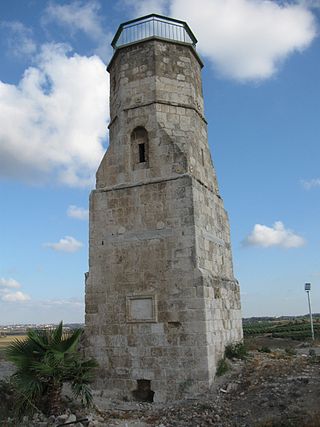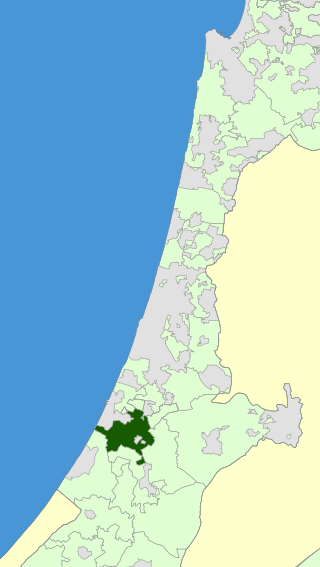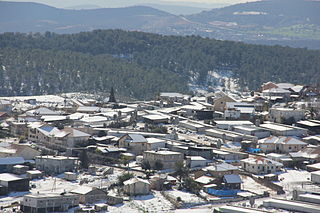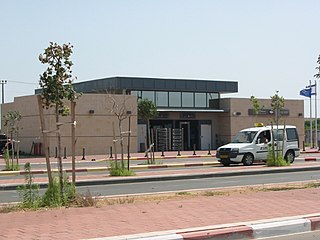
Yavne is a city in the Central District of Israel. In 2022, it had a population of 56,232.
Yohanan ben Zakkai, sometimes abbreviated as ריב״ז ribaz for Rabbi Yohanan ben Zakkai, was a tanna, an important Jewish sage during the late Second Temple period during the transformative post-destruction era. He was a primary contributor to the core text of Rabbinic Judaism, the Mishnah. His name is often preceded by the honorific title Rabban. He is widely regarded as one of the most important Jewish figures of his time, and his escape from the Roman destruction of Jerusalem may have been instrumental in Rabbinic Judaism's survival post-Temple. His tomb is located in Tiberias within the Maimonides burial compound.

Yibna, or Tel Yavne, is an archaeological site and depopulated Palestinian town. The ruins are located southeast of the modern Israeli city of Yavne.

Sepphoris, known in Hebrew as Tzipori and in Arabic as Saffuriya is an archaeological site and former Palestinian village located in the central Galilee region of Israel, 6 kilometres (3.7 mi) north-northwest of Nazareth. It lies 286 meters (938 ft) above sea level and overlooks the Beit Netofa Valley. The site holds a rich and diverse historical and architectural legacy that includes remains from the Hellenistic, Roman, Byzantine, early Islamic, Crusader, Mamluk and Ottoman periods.

Gan-Yavne is a town in central Israel, located adjacent to the city of Ashdod. Gan Yavne was founded in 1931 and achieved local council status in 1950. It later expanded to incorporate the ruins of the depopulated Palestinian town of Barqa, today an archaeological area containing ancient tombs and a Byzantine mosaic.

Hamaam, or Wadi Hamam, is an Arab village in northern Israel, located near the Sea of Galilee, at the foot of Mount Nitai and across the Wadi Hamam valley from Mount Arbel. It is the easternmost part of the al-Batuf Regional Council. In 2022 its population was 1,561.

The Upper Galilee is a geographical region located in northern Israel and southern Lebanon. Part of the larger Galilee region, it is characterized by its higher elevations and mountainous terrain. The term "Upper Galilee" is ancient, and has been in use since the end of the Second Temple period. From a political perspective, the Upper Galilee is situated within the administrative boundaries of the Northern District of Israel.
The Talmudic academies in Syria Palaestina were yeshivot that served as centers for Jewish scholarship and the development of Jewish law in Syria Palaestina, and later Palaestina Prima and Palaestina Secunda. The academies had a major influence on Judaism through the development of the Jerusalem Talmud, or Palestinian Talmud, which was compiled into book form in around 350–400 CE.

Har Halutz, officially known as Halutz is a community settlement in the central Galilee in northern Israel. Har Halutz is located in the rocky terrain of Gush Tefen and belongs to the Misgav Regional Council. In 2022 it had a population of 551.

Be'er Tuvia Regional Council, is a regional council in the Southern District of Israel.

Dalton is a moshav near Safed in northern Israel under the jurisdiction of Merom HaGalil Regional Council. It was founded by immigrants from Tripoli in Libya in 1950 under the leadership of Hapoel HaMizrachi.

Kfar HaNagid is a moshav in central Israel. Located in the coastal plain around 20 km south of Tel Aviv and north of Yavne, it falls under the jurisdiction of Gan Raveh Regional Council. In 2022 it had a population of 1,226.
Ben Zakai is a religious moshav in central Israel. Located in the Shephelah, it falls under the jurisdiction of Hevel Yavne Regional Council. In 2022 it had a population of 1,080.

Chorazin or Korazim was an ancient village in the Roman and Byzantine periods, best known from the Christian Gospels. It stood on the Korazim Plateau in the Upper Galilee on a hill above the northern shore of the Sea of Galilee, 2.5 mi (4.0 km) from Capernaum in what is now the territory of modern Israel.

The mausoleum of Abu Hurayra, or Rabban Gamaliel's Tomb, is a maqam turned synagogue in HaSanhedrin Park in Yavne, Rehovot Subdistrict, in the Central District of Israel, formerly belonging to the depopulated Palestinian village of Yibna. It has been described as "one of the finest domed mausoleums in Palestine."

Yavne-Yam or Minet Rubin is an archaeological site located on Israel's Southern Coastal Plain, about 15 km south of Tel Aviv. Built on eolianite hills next to a small promontory forming the sole anchorage able to provide shelter to seagoing vessels between Jaffa and the Sinai, Yavne-Yam is notable for its role as the port of ancient Yavne. Excavations carried out by Tel Aviv University since 1992 have revealed continuous habitation from the second millennium BCE up to the Middle Ages; the famous Yavne-Yam ostracon is named after the site.

Yavne–East railway station is one of two railway stations in Yavne, Israel. It is on the suburban line Binyamina/Netanya–Tel Aviv–Rehovot/Ashkelon. Yavne East was opened in 1992 and was fully rebuilt in 2009.
Ibelin was a crusader castle in the Latin Kingdom of Jerusalem at the town of Ibelin, later known as Yibna, and today southeast of the modern Israeli city of Yavne. Very little remains of the castle, but its ruins have been located in the center of Yibna, today known as "Tel Yavne".
The Lod–Ashkelon railway is a railway line linking Lod and Ashkelon. It is operated by Israel Railways, and spans approximately 50 km of mostly double track in central and southern Israel.

Jamnith, also Jabnith, Yavnit, Iamnia, or in medieval parlance, Ibnit / Abnit / Ovnit, is a ruin in the Upper Galilee that came to renown during the First Jewish Revolt in the 1st-century CE. The ruin, known locally by the name Khurbet esh-Sheikh Banit, or simply Kh. Banît, lies about 3.4 kilometres (2.1 mi) to the northeast of Safed, in the Biriya Forest, and was once a fortified town towards the northeast of Mount Canaan, upon a hill called Har Yavnit. The hill on which the village ruins lie rises 836 metres (2,743 ft) above sea level and overlooks the Hula valley. Access to the ruin is now restricted because of an enclosed military installation built over the site.














